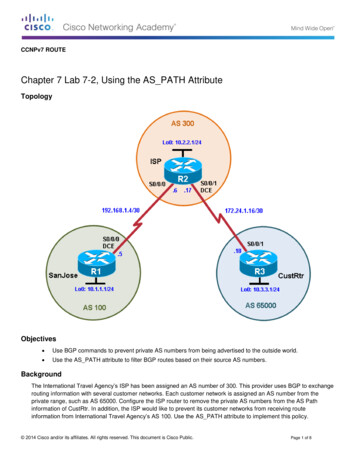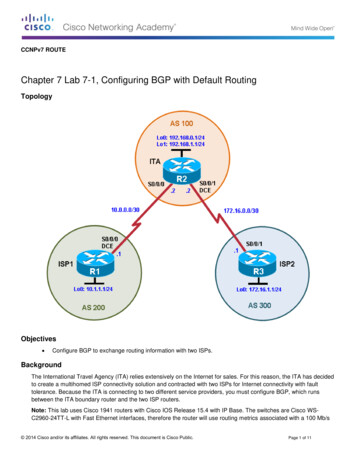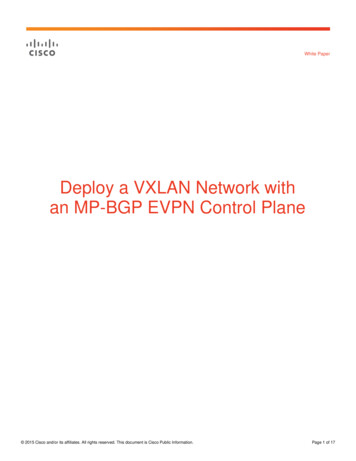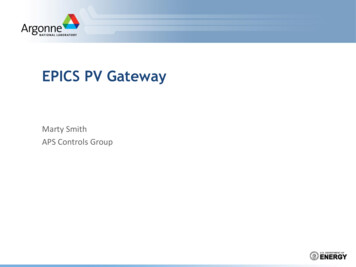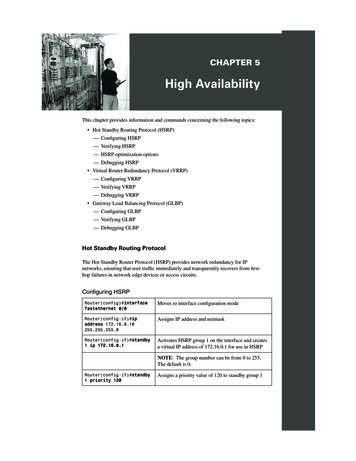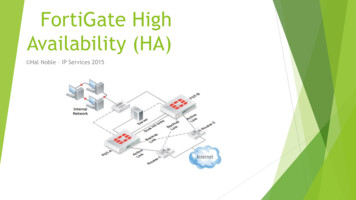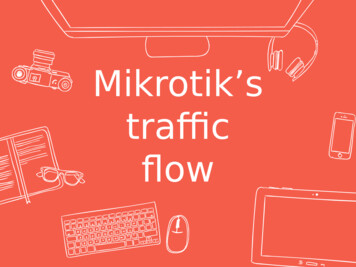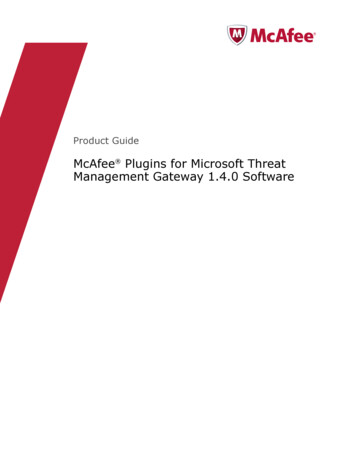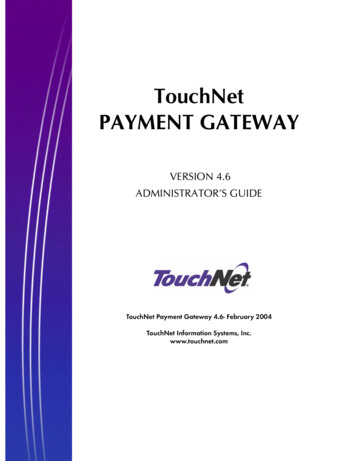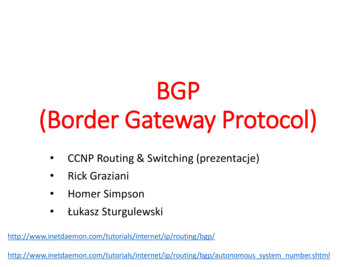
Transcription
BGP(Border Gateway Protocol) CCNP Routing & Switching (prezentacje)Rick GrazianiHomer SimpsonŁukasz torials/internet/ip/routing/bgp/autonomous system number.shtml
Terms IGP (Interior Gateway Protocol) - RIP, IGRP, EIGRP, OSPF Routingprotocol used to exchange routing information within an autonomoussystem. EGP (Exterior Gateway Protocol) - BGP Routing protocol used toexchange routing information between autonomous systems. Autonomous System (From RFC 1771) “A set of routers under thesingle technical administration, using an IGP and common metrics toroute packets within the AS, and using an EGP to route packets to otherAS’s.” BGP is a path vector or an advanced distance vector routing protocol.2
IGP vs EGP
IGP versus EGP Interior gateway protocol (IGP) A routing protocol operating within an Autonomous System (AS). RIP, OSPF, and EIGRP are IGPs. Exterior gateway protocol (EGP) A routing protocol operating between different AS. BGP is an interdomain routing protocol (IDRP) and is an EGP.Withdrawn
IGP versus EGP BGP works differently than IGPs because it does notmake routing decisions based on best path metrics. Instead, BGP is a policy-based routing protocol thatallows an AS to control traffic flow using multiple BGPattributes. Routers running BGP exchange network attributesincluding a list of the full path of BGP AS numbersthat a router should take to reach a destinationnetwork. BGP allows an organization to fully use all of itsbandwidth by manipulating these path attributes.5
IGP versus EGPProtocolInterior istance vectorNoHop countOSPFInteriorLink stateYesCostIS-ISInteriorLink stateYesMetricEIGRPInteriorAdvanceddistance vectorNoCompositeBGPExteriorPath vectorNoPath vectors(attributes)
Autonomous Systems (AS)7
Autonomous Systems (AS) An AS is a group of routers that share similar routingpolicies and operate within a single administrativedomain. An AS typically belongs to one organization. A single or multiple interior gateway protocols (IGP) may beused within the AS. In either case, the outside world views the entire AS as asingle entity. If an AS connects to the public Internet using anexterior gateway protocol such as BGP, then it must beassigned a unique AS number which is managed by theInternet Assigned Numbers Authority (IANA).8
IANA The IANA is responsible for allocating AS numbers through fiveRegional Internet Registries (RIRs). RIRs are nonprofit corporations established for the purpose ofadministration and registration of IP address space and AS numbers in keygeographic locations.
Regional Internet Registries (RIRs)RIR NameAfriNICGeographic CoverageLinkContinent of Africawww.afrinic.netAsia Pacific regionwww.apnic.orgCanada, the United States, andseveral islands in the CaribbeanSea and North Atlantic Oceanwww.arin.netCentral and South America andportions of the Caribbeanwww.lacnic.netAPNIC(Asia Pacific NetworkInformation Centre)ARIN(American Registry for InternetNumbers)LACNIC(Latin America and CaribbeanInternet Addresses Registry)RIPE(Réseaux IP Européens)Europe, the Middle East, andCentral Asiawww.ripe.net
AS Numbers AS numbers can be between 1 to 65,535. RIRs manage the AS numbers between 1 and 64,512. The 64,512 - 65,535 numbers are reserved for private use (similarto IP Private addresses). The IANA is enforcing a policy whereby organizations that connectto a single provider use an AS number from the private pool. Note: The current AS pool of addresses is predicted to run out by 2012. For this reason, the IETF has released RFC 4893 and RFC 5398. These RFCs describe BGP extensions to increase the AS numberfrom the two-octet (16-bit) field to a four-octet (32-bits) field,increasing the pool size from 65,536 to 4,294,967,296 values.11
When to use BGP and when not to use BGPUse BGP when the effects of BGP are well understood and one of the followingconditions exist: The AS allows packets to transit through it to reach another AS (transit AS). The AS has multiple connections to other AS’s. The flow of traffic entering or exiting the AS must be manipulated.This is policy based routing and based on attributes.14
When to use BGP and when not to use BGPDo not use BGP if you have one or more of the following conditions: A single connection to the Internet or another AS No concern for routing policy or routing selection A lack of memory or processing power on your routers to handle constant BGPupdates A limited understanding of route filtering and BGP path selection process Low bandwidth between AS’s15
Connection RedundancyConnecting to One ISPConnecting to Two or more d
Single-homed autonomous systemsStatic Route If an AS has only one exit point to outside networks, it is considered a singlehomed system. Single-homed autonomous systems are often referred to as stub networks orstubs. Stubs can rely on a default route to handle all traffic destined for non-localnetworks. BGP is not normally needed in this situation.18
Using Static Routes Example Static routes are the simplest way to implement routing with anISP. Typically a customer has a single connection to an ISP and the customeruses a default route toward the ISP while the ISP deploys static routestoward the customer.R1(config)# router eigrp 110R1(config-router)# network 10.0.0.0R1(config-router)# exitR1(config)# ip default-network 0.0.0.0R1(config)# ip route 0.0.0.0 0.0.0.0 serial 0/0/0ISPCompany 1PE(config)# ip route 10.0.0.0 255.0.0.0 serial 0/0/1PE(config)# ip route 172.16.0.0 255.255.0.0 serial 0/0/1PE(config)# ip route 172.17.0.0 255.255.0.0 serial 0/0/1PE
Single-homed autonomous systems Use an IGP – Both the provider and the customer use an IGP to shareinformation regarding the customer's networks. This provides the benefits associated with dynamic routing. BGP is not normally needed in this situation.20
Single-homed autonomous systems Use an EGP – The third method by which the ISP can learn and advertise thecustomer's routes is to use an EGP such as BGP. In a single-homed autonomous system the customer's routing policies are anextension of the policies of the provider. For this reason the Internet number registries are unlikely to assign an ASnumber. Instead, the provider can give the customer an AS number from theprivate pool of AS numbers, 64,512 to 65,535. The provider will strip off these numbers when advertising the customer'sroutes towards the core of the Internet.21
Dual-HomedISPCompany AOption 1:InternetPER1ISPCompany AOption 2:InternetPER1R2ISPSummarized network address0.0.0.0/0Cost 10Type E1OSPF0.0.0.0/0Cost 10Type E1
Dual-Homed to a Single Autonomous SystemsISPSummarized network address0.0.0.0/0Cost 10Type E1OSPF0.0.0.0/0Cost 10Type E1 This is an improved topology over Single-Home AS, providing for redundancy. One option may be to use one link as the primary link and the other as abackup link. A better design would be to use both paths, with each one providing backupfor the other in the event of link or router failure. In most cases this will be sufficient for good internetwork performance.23
Multihomed nontransit autonomous systemsOr same ISP An AS is a multihomed system if it has more than one exit point to outsidenetworks. A non-transit AS does not allow transit traffic-that is, any traffic that has a sourceand destination outside the AS—to pass through it. A non-transit AS would advertise only its own routes to both the providers itconnects to—it would not advertise routes it learned from one provider toanother. This makes certain that ISP1 will not use AS 24 to reach destinations that belong toISP2, and ISP2 would not use AS 24 to reach destinations that belong to ISP1.24
Multihomed nontransit autonomous systemsOr same ISP Multihomed nontransit autonomous systems do not really need to run BGP4with their providers. It is usually recommended and often required by ISPs. As it will be seen later in this module, BGP4 offers numerous advantages,including increased control of route propagation and filtering.25
Multihomed nontransit autonomous systems Incoming route advertisements influence your outgoing traffic, and outgoingadvertisements influence your incoming traffic. If the provider advertises routes into your AS via BGP, your internal routers havemore accurate information about external destinations. BGP also provides tools for setting routing policies for external destinations. If your internal routes are advertised to the provider via BGP, you have influenceover which routes are advertised at which exit point. BGP also provides tools for your influencing (to some degree) the choicesthe provider makes when sending traffic into your AS.26
Multi-homed Transit Autonomous Systems A multi-homed transit system has more than one connection to the outsideworld and can be used for transit traffic by other autonomous systems. From the point of view of the multi-homed AS, transit traffic is any trafficoriginating from outside sources bound for outside destinations27
Multi-homed Transit Autonomous SystemsEdge Router When BGP is running inside an AS, it is referred to as Internal BGP (IBGP). When BGP runs between autonomous systems, it is called External BGP(EBGP). If the role of a BGP router is to route IBGP traffic, it is called a transit router. Routers that sit on the boundary of an AS and that use EBGP to exchangeinformation with the ISP are called border or edge routers.28
Three Multihoming Connection Options1. Each ISP passes only a default route to the AS. The default route is passed on to internal routers.2. Each ISP passes only a default route and providerowned specific routes to the AS. These routes may be propagated to internal routers, orall internal routers in the transit path can run BGP toexchange these routes.3. Each ISP passes all routes to the AS. All internal routers in the transit path run BGP toexchange these routes.29
Default Routes from All Providers30
Default Routes and PartialUpdates31
Full Routes from All Providers
EBGP vs IBGP
External BGP EBGP neighbors are in different autonomoussystems. EBGP neighbors need to be directly connected.34
EBGP Neighbors RelationshipRequirements Define neighbors: A TCP session (three-way handshake) must beestablished before starting BGP routing updateexchanges. Reachability: EBGP neighbors are usually directly connected. Different AS number: EBGP neighbors must have different AS numbers.35
Internal BGP IBGP neighbors are in the same autonomoussystems. IBGP neighbors do not need to be directly connected.36
IBGP Neighbors RelationshipRequirements Define neighbors: A TCP session (three-way handshake) must beestablished before starting BGP routing updateexchanges. Reachability: IBGP neighbors must be reachable usually by using anIGP. Loopback IP addresses are typically used to identify IBGPneighbors. Same AS number: IBGP neighbors must have the same AS number.37
IBGP in a Transit AS A transit AS is an AS that routes traffic from one external AS toanother external AS. Transit AS network are typically ISPs. All routers in a transit autonomous system must have completeknowledge of external routes.
IBGP in a Nontransit AS A nontransit AS is an AS that does not route trafficfrom one external AS to another external AS. Nontransit AS networks are typically enterprisenetworks. All routers in a nontransit autonomous system muststill have complete knowledge of external routes. To avoid routing loops within an AS, BGP specifiesthat routes learned through IBGP are neverpropagated to other IBGP peers. It is assumed that the sending IBGP neighbor is fullymeshed with all other IBGP speakers and has sent eachIBGP neighbor the update.39
IBGP vs EBGP When BGP is running inside an AS, it isreferred to as Internal BGP (IBGP). If a BGP router’s role is to routeIBGP traffic, it is called a transitrouter. When BGP runs between autonomoussystems, it is called External BGP(EBGP). Routers that sit on the boundaryof an AS and use EBGP toexchange information with the ISPare called border routers. “With very few exceptions, interiorBGP (IBGP) – BGP between peers inthe same AS – is used only inmultihomed scenarios.” – DoyleAS 24192.168.1.216/30AS 20040
Routers A and B are running EBGP (BGP), and Routers B and C are runningIBGP. Note that the EBGP (BGP) peers are directly connected and that the IBGPpeers are not. (They can be.) As long as there is an IGP running that allows the two neighbors to reach oneanother, IBGP peers do not have to be directly connected. More later!41
All BGP speakers within an AS must establish a peer relationship with eachother, that is, the BGP speakers within an AS must be fully meshed logically.(later) BGP4 provides two techniques that alleviate the requirement for a logical fullmesh: confederations and route reflectors. (later) AS 200 is a transit AS for AS 100 and AS 300---that is, AS 200 is used totransfer packets between AS 100 and AS 300.42
BGP in an Enterprise Example Enterprise AS 65500 is learningroutes from both ISP-A and ISP-Bvia EBGP and is also running IBGPon all of its routers. If one of the connections to the ISPsgoes down, traffic will be sent throughthe other ISP. An undesirable situation couldoccur is the enterprise AS isconfigured as a transit AS. For example, AS 65500 learns the172.18.0.0/16 route from ISP-A. If router B advertises that route to ISPB, then ISP-B may decide to use it. This undesirable configuration couldbe avoided through careful BGPconfiguration.
BGP Hazards – Doyle, Routing TCP/IP Creating a BGP “peering” relationship involves an interesting combination oftrust and mistrust. You must trust the network administrator on that end to know what they aredoing. At the same time, if you are smart, you will take every practical measure toprotect yourself in the event that a mistake is made on the other end. “Paranoia is your friend.”44
BGP Hazards – Doyle, Routing TCP/IP Your ISP will show little patience with you if you make mistakes in your BGPconfiguration. Suppose, for example, that through some misconfiguration you advertise207.46.0.0/16 to your ISP. On the receiving side, the ISP does not filter out this incorrect route,allowing it to be advertised to the rest of the Internet. This particular CIDR block belongs to Microsoft, and you have just claimed tohave a route to that destination. A significant portion of the Internet community could decide that the bestpath to Microsoft is through your domain. You will receive a flood of unwanted packets across your Internetconnection and, more importantly, you will have black-holed traffic thatshould have gone to Microsoft. They will be neither amused nor understanding.45
BGP Basics
BGP Basics Internal routing protocolsannounce a list of networks andthe metrics to get to eachnetwork. In contrast, BGP routers exchangenetwork reachability information,called path vectors, made up ofpath attributes. BGP is a path vector routing protocol. BGP version 4 (BGP-4) is the latest version of BGP. Defined in RFC 4271. Supports supernetting (CIDR) and VLSM . BGP4 and CIDR prevent the Internet routing table from becoming too large. Without CIDR, the Internet would have few millions entries. With CIDR, Internet core routers manage around 600,000 entries. http://bgp.potaroo.net/ BGP is a distance vector routing protocol, in that it relies on downstream neighbors to pass along routesfrom their routing table. BGP uses a list of AS numbers through which a packet must pass to reach a destination.47
BGP Basics The function of BGP is to: Exchange routing information between autonomous systems Guarantee the selection of a loop free path. BGP4 is the first version of BGP that supports CIDR and route aggregation. Common IGPs such as RIP, OSPF, and EIGRP use technical metrics. BGP does not use technical metrics. BGP makes routing decisions based on network policies, or rules (later) BGP does not show the details of topologies within each AS. BGP sees only a tree of autonomous systems. Cisco routers maintain a separate routing table to hold BGP routes:show ip bgp48
BGP Basics BGP updates are carried using TCP on port 179. In contrast, RIP updates use UDP port 520 OSPF, IGRP, EIGRP does not use a Layer 4 protocol Because BGP requires TCP, IP connectivity must exist between BGP peers. TCP connections must also be negotiated between them before updates canbe exchanged. Therefore, BGP inherits those reliable, connection-oriented properties fromTCP.49
# of Current BGP RoutesAs of May 25, 2016, there were 619.795 routes in the routing tables of the Internetcore bgpupd.html7 Day BGP Profile: 18-May-2016 00:00 - 24-May-2016 23:59 (UTC 1000)Number of BGP Update Messages:1876653Number of Prefix Updates:4143042Number of Prefix Withdrawals:204703Average Prefixes per BGP Update: 2.32Average BGP Update Messages per second:Average Prefix Updates per second:Peak BGP Update Message Rate per second:Peak Prefix Update Rate per second:Peak Prefix Withdraw Rate per second:Prefix Count:619796Updated Prefix Count:619795Stable Prefix Count:1Origin AS Count: 54098Updated Origin AS Count: 54068Stable Origin AS Count:30Unique Path Count:289501Updated Path Count:257356Stable Path Count:321452.726.296141441230330(06:48:01 Tue, 24-May-2016)(17:05:17 Tue, 17-May-2016)(06:48:02 Tue, 24-May-2016)
BGP BasicsBGP Path Vector Characteristics The path vector information includes: A list of the full path of BGP AS numbers (hop by hop) necessary to reach adestination network. Other attributes including the IP address to get to the next AS (the next-hopattribute) and how the networks at the end of the path were introducedinto BGP (the origin code attribute).
BGP BasicsPeers Neighbors A “BGP peer,” also known as a “BGP neighbor,” is aspecific term that is used for BGP speakers thathave established a neighbor relationship. Any two routers that have formed a TCP connectionto exchange BGP routing information are calledBGP peers or BGP neighbors.52
BGP Operational Overview When two routers establish a TCP enabled BGP connection, theyare called neighbors or peers. Peer routers exchange multiple connection messages. Each router running BGP is called a BGP speaker.
BGP Operational Overview When BGP neighbors first establish a connection, they exchangeall candidate BGP routes. After this initial exchange, incremental updates are sent as networkinformation changes.
Withdrawn Routes The information for network reachability can change, such as when a routebecomes unreachable or a better path becomes available. BGP informs its neighbors of this by withdrawing the invalid routes andinjecting the new routing information. Withdrawn routes are part of the update message. BGP routers keep a tableversion number that tracks the version of the BGP routing table received fromeach peer. If the table changes, BGP increments the table version number. A rapidly incrementing table version is usually an indication of instabilities inthe network, or a misconfiguration.55
Loop Free Path To guarantee loop free path selection, BGP constructs a graph of autonomoussystems based on the information exchanged between BGP neighbors. BGP views the whole internetwork as a graph, or tree, of autonomoussystems. The connection between any two systems forms a path. The collection of path information is expressed as a sequence of AS numberscalled the AS Path. This sequence forms a route to reach a specific destination56
Loop Free Path172.16.0.0/16(4, 2, 1)172.16.0.0/16(6, 5, 3, 1)AS7AS4AS6AS2AS5AS3AS1172.16.0.0/16 The list of AS numbers associated with a BGP route is called the AS PATH and isone of several path attributes associated with each route. Path attributes will be discussed in much more detail later. The shortest inter-AS path is very simply determined by the least number of ASnumbers. All things being equal, BGP prefers routes with shorter AS paths. In this example, AS7 will choose the shortest path (4, 2, 1). We will see later what happens with equal cost paths.57
Loop Free ,1)AS9X172.16.0.0/16(9,8,7,4,2,1)172.16.0.0/16(4, 2, 1)AS7AS4AS6AS2AS5AS3AS1172.16.0.0/16Routing Loop Avoidance Route loops can be easily detected when a router receivesan update containing its local AS number in the AS PATH. When this occurs, the router will not accept the update,thereby avoiding a potential routing loop.58
BGP Databases Neighbor table List of BGP neighbors BGP table (forwarding database) List of all networks learned from each neighbor Can contain multiple paths to destination networks Contains BGP attributes for each path IP routing table List of best paths to destination networks59
BGP Table BGP keeps its own table for storing BGPinformation received from and sent BGP neighbors. This table is also known as the BGP table, BGP topologytable, BGP topology database, BGP routing table, andthe BGP forwarding database. The router offers the best routes from the BGPtable to the IP routing table.60
BGP RoutingProcess BGP is so flexible because it is a fairly simple protocol. Routes are exchanged between BGP peers via UPDATE messages. BGP routers receive the UPDATE messages, run some policies or filters over theupdates, and then pass on the routes to other BGP peers. The Cisco implementation of BGP keeps track of all BGP updates in a BGP tableseparate from the IP routing table.61
BGP Routing Process The Cisco implementation of BGP keeps track of all BGP updates in a BGP tableseparate from the IP routing table. In case multiple routes to the same destination exist, BGP does not flood itspeers with all those routes. Instead, BGP picks only the best route and sends itto the peers. In addition to passing along routes from peers, a BGP router may originaterouting updates to advertise networks that belong to its own AS. Valid local routes originated in the system and the best routes learned fromBGP peers are then installed in the IP routing table. The IP routing table is used for the final routing decision.62
BGP Message Types Before establishing a BGP peer connection the two neighbors must performthe standard TCP three-way handshake and open a TCP connection to port179. After the TCP session is established, BGP peers exchanges several messages toopen and confirm connection parameters and to send BGP routinginformation. All BGP messages are unicast to the one neighbor over the TCP connection. There are four BGP message types: Type 1: OPENType 2: KEEPALIVEType 3: UPDATEType 4: NOTIFICATION63
BGP Message TypesEach BGP Message contains the following header: Marker: The marker field is used to either authenticate incoming BGPmessages or to detect loss of synchronization between two BGP peers. Length: The length field indicates the total BGP message length, including theheader (messages may be between 19 and 4096 bytes long).64
BGP Message HeaderOpen ld TimeBGP IDOptionalLengthOptionalUpdate engthTypeUnfeasible esNLRINotification MessageOctets162111VariableMarkerLengthTypeError CodeErrorSub-codeDiagnosticDataKeepalive MessageOctets1621MarkerLengthType65
Types of BGP MessagesOpen ld TimeBGP IDOptionalLengthOptionalUpdate engthTypeUnfeasible esNLRINotification MessageOctets162111VariableMarkerLengthTypeError CodeErrorSub-codeDiagnosticDataKeepalive MessageOctets1621MarkerLengthType66
Type 1:BGP Open Message After the TCP session is established, both neighbors send Open messages which includes aset of parameters that have to be agreed upon before a full BGP adjacency can beestablished. This message is used to establish full connections with peers. Each neighbor uses this message to identify itself and to specify its BGP operationalparameters including: BGP version number (defaults to version 4) AS number: AS number of the originating router, determines if BGP session is EBGPor IBGP. BGP identifier: IP address that identifies the neighbor using the same method asOSPF router ID. Optional parameter: authentication, multiprotocol support and route refresh.162112241MarkerLengthTypeVersionASHold TimeBGP IDOptionalLength7Optional67
Type 2:BGP Keepalive Message Keepalive messages are sent between peers every60 seconds (by default) to maintain connections. The message consist of only a message header (19bytes). Hold time is three times the KEEPALIVE timer of 60seconds. If the periodic timer 0, no keepalives are sent. Recommended keepalive interval is one-third of thehold time interval.Octets1621MarkerLengthType68
Type 3: BGP Update Message Update messages contain all the information BGPuses to construct a loop-free picture of theinternetwork. A BGP update message has information on onepath only; multiple paths require multiple updatemessages. All the attributes in the update message refer to thatpath, and the networks are those that can be reachedthrough hTypeUnfeasibleRoutes NLRI69
Type 3: BGP Update Message An update message includes the followinginformation: Unreachable routes information Path attribute information Network-layer reachability information (NLRI) This field contains a list of IP address prefixes that arereachable by this path. 192.168.160.0/19Prefix 192.168.160.0Prefix Length 19Unreachable Routes InformationOctetsNLRIInformationPath eMarkerLengthTypeUnfeasibleRoutes NLRI70
NLRI format The NLRI is a list of length, prefix tuples. One tuple for each reachable destination. The prefix represents the reachable destination The prefix length represents the # of bits set in thesubnet mask.IP Address Subnet MaskNLRI10.1.1.0 255.255.255.024, 10.1.1.0192.24.160.0 255.255.224.019, 192.24.160.071
Type 4: BGP Notification Message A BGP notification message is sent when an errorcondition is detected. The BGP connection is closed immediately after this issent. Notification messages include an error code, anerror subcode, and data related to the error.Octets162111VariableMarkerLengthTypeError CodeErrorSub-codeDiagnosticData72
Type 4:BGP Notification Message Sample error codes and theirassociated subcodes.
BGP FSM The BGP neighbor negotiation process proceedsthrough various states, or stages, which can bedescribed in terms of a finite-state machine (FSM).74
BGP FSMBGP FSM includes six states:1.2.3.4.5.6.IdleConnectActiveOpenSentOpen ConfirmEstablished75
Idle State BGP always begins in the Idle state, in which it refuses all incoming connections. It is normally initiated by an administrator or a network event. When Start event occurs, the BGP process: Initializes all BGP resources Starts the ConnectRetry timer Initializes a TCP connection to the neighbor Listens for a TCP initialization from the neighbor Changes its state to Connect76
Connect State In this state, the BGP process is waiting for the TCP connection to becompleted. If the connection is successful, the BGP process: Clears the ConnectRetry timer Completes initialization Sends an Open message to the neighbor Transitions to the OpenSent state77
Connect State If the connection is unsuccessful, the BGP process: Continues to listen for a connection to be initiated by the neighbor Resets the ConnectRetry timer Transitions to the Active state78
Active State In this state, the BGP process is trying to initiate a TCP connection with theneighbor. If the TCP connection is successful: Clears the ConnectRetry timer Completes initialization Sends an Open message to the neighbor Transitions to the OpenSent state79
Active State If the ConnectRetry timer expires while BGP is in the Active State, the BGPprocess: Transitions back to the Connect state Resets the ConnectRetry timer In general, a neighbor state that is switching between "Connect" and "Active"is an indication that something is wrong and that there are problems with theTCP connection. It could be because of many TCP retransmissions, or the incapability of aneighbor to reach the IP address of its peer.80
OpenSent StateerrorsNo errors In this state an Open message has been sent and BGP is waiting to hear anOpen message from its neighbor. When an Open message is received, all its fields are checked. If errors exist, a Notification message is sent and the state transitions toIdle. If no errors exist, a Keepalive message is sent and the Keepalive timer isset, the peer is determined to be internal or external, and state is changedto OpenConfirm.81
OpenConfirmStateerrorNo errors In this state, the BGP process waits for a Keepalive or Notification message. If a Keepalive message is received, the state transitions to Established. If a Notification message is received, or a TCP disconnect is received, the st
Terms IGP (Interior Gateway Protocol) - RIP, IGRP, EIGRP, OSPF Routing protocol used to exchange routing information within an autonomous system. EGP (Exterior Gateway Protocol) - BGP Routing protocol used to exchange routing information between autonomous systems. Autonomous System (From RF 1771) "A set of routers under the single technical administration, using an IGP and .
